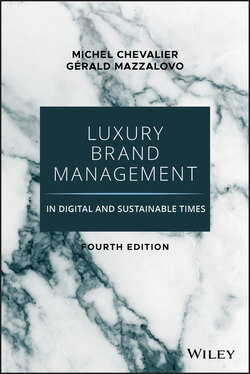Читать книгу Luxury Brand Management in Digital and Sustainable Times - Michel Chevalier - Страница 56
What Is the Size of the Luxury Market?
ОглавлениеAs we said earlier, in luxury, size is relative. As there is very little data available on the size of the total market, we are obliged to come up with our own guesstimates of this activity; we start with the very precise estimates that are published each year by consulting firm Bain & Company, and are very precise.
It all depends, of course, on whether we consider luxury in its more limited scope (fashion, accessories including leather goods, cosmetics and fragrances, wines and spirits, etc.) or if we also include luxury cars (which Bain values at €500 billion), private airplanes, and travel, including hotels (which Bain values at €190 billion) and hospitality. In the larger category, the total turnover of the corporations manufacturing products or rendering direct services could be all the way to €1,200 billion. If we take the Bain figures for what they call “personal luxury,” we find the figures shown in Table 2.3.
We consider these sales statistics to be very precise and well analyzed, but we want to also include wines and spirits and tablewares (a total of €71 billion) in our tables. This is shown in Table 2.4.
Let us explain how our numbers differ from Bain's. We believe that their figures for accessories are very high but we don't want to depart from them. For wines and spirits, we considered “luxury wines” to be only wines that would retail for more than €10 a bottle. We have very different estimates for jewelry and watches because we decided to include in the jewelry those watches that were sold under a jewelry brand by a jeweler.
Table 2.3 Bain's Estimates of Business Size, 2018 (€ billion)
Source: Bain annual study on personal luxury, 2018.
| Apparel | 60 |
| Accessories | 75 |
| Jewelry and watches | 51 |
| Beauty | 51 |
| Total | 237 |
Table 2.4 Our Estimates of Basic Luxury Products Business Sales, 2019 (€ billion)
| Apparel | 60 |
| Accessories | 75 |
| Spirits and luxury wines | 65 |
| Perfumes and cosmetics | 65 |
| Watches | 26 |
| Jewelry | 45 |
| Tableware | 6 |
| Total | 342 |
Table 2.5 Estimates of the Respective Contributions of French and Italian Companies
Source: These figures are based on the authors' discussions with different industry specialists.
| Total (€ billion) | French (%) | Italian (%) | Others (%) | |
|---|---|---|---|---|
| Ready-to-wear | 60 | 20 | 30 | 50 |
| Accessories | 75 | 25 | 35 | 40 |
| Alcohol and expensive wines | 65 | 15 | 10 | 75 |
| Fragrances and cosmetics | 65 | 35 | 5 | 60 |
| Watches | 26 | 5 | 5 | 90 |
| Jewelry | 45 | 7.5 | 5 | 87.5 |
| Tableware | 6 | 40 | 10 | 50 |
| Total | 342 |
Based on these estimates, we compare the relative size of the French and Italian companies, as set out in Table 2.5. Again, these figures are our own estimates and have been rounded up.
In the ready-to-wear category, Italy and France have 55% of the market between them, with Italy clearly leading the way. The others category comprises countries such as the United States and England. However, if we confine ourselves to luxury, and therefore do not take into account brands such as Liz Claiborne, Gap, or Banana Republic, the United States, with the exception of Ralph Lauren or Michael Kors, is not very strong in this category.
In the watches category, which is obviously dominated by the Swiss, the French and Italians are merely secondary players.
Of the overall total, French and Italian brands account for €75 billion and €60 billion, respectively. France's strong position is built around accessories and perfumes. With the exception of Armani, Gucci, and Dolce & Gabbana, Italy seems to have been unable to impose strong perfume brands, and on top of this, those brands are not developed by Italian companies; nor does it have a strong international market in spirits.
However, Italy's strength in fashion is quite visible. Where France has 8 brands with sales of over €1 billion (Balenciaga, Cartier, Chanel, Dior, Hermès, Louis Vuitton, Saint Laurent, and Van Cleef & Arpels), with four whose core business is in the ready-to-wear world, Italy has 15 (Armani, Bottega Veneta, Bulgari, Dolce & Gabbana, Fendi, Gucci, Loro Piana, Max Mara, Moncler, Prada, Salvatore Ferragamo, Valentino, Versace, and Zegna), with 14 coming from the ready-to-wear and fashion world.
This preeminence of Italian fashion will have unexpected consequences in the long run as perfume brands are often built on the strength of ready-to-wear lines. If one day the Gucci, Prada, and Versace perfumes reach parity with those of Chanel, Dior, and Yves Saint Laurent, then Italy could become the number-one luxury operator in the world.
For reasons that will be discussed later, the French have been very slow to develop fashion and ready-to-wear brands over the past 30 years. The two major creations of French fashion brands date back to Saint Laurent and Kenzo; somehow, this looks like ancient history.
